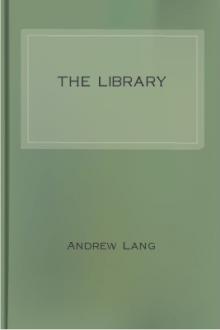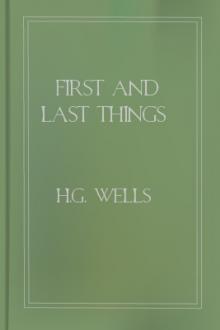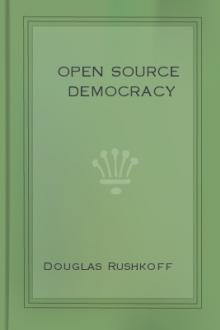The Library by Andrew Lang (i have read the book a hundred times txt) 📕

- Author: Andrew Lang
- Performer: -
Book online «The Library by Andrew Lang (i have read the book a hundred times txt) 📕». Author Andrew Lang
Just as the house of Aldus waned and expired, that of the great Dutch printers, the Elzevirs, began obscurely enough at Leyden in 1583. The Elzevirs were not, like Aldus, ripe scholars and men of devotion to learning. Aldus laboured for the love of noble studies; the Elzevirs were acute, and too often “smart” men of business. The founder of the family was Louis (born at Louvain, 1540, died 1617).
But it was in the second and third generations that Bonaventura and Abraham Elzevir began to publish at Leyden, their editions in small duodecimo. Like Aldus, these Elzevirs aimed at producing books at once handy, cheap, correct, and beautiful in execution. Their adventure was a complete success. The Elzevirs did not, like Aldus, surround themselves with the most learned scholars of their time.
Their famous literary adviser, Heinsius, was full of literary jealousies, and kept students of his own calibre at a distance. The classical editions of the Elzevirs, beautiful, but too small in type for modern eyes, are anything but exquisitely correct. Their editions of the contemporary. French authors, now classics themselves, are lovely examples of skill in practical enterprise.
The Elzevirs treated the French authors much as American publishers treat Englishmen. They stole right and left, but no one complained much in these times of slack copyright; and, at all events, the piratic larcenous publications of the Dutch printers were pretty, and so far satisfactory. They themselves, in turn, were the victims of fraudulent and untradesmanlike imitations. It is for this, among other reasons, that the collector of Elzevirs must make M. Willems’s book (“Les Elzevier,” Brussels and Paris, 1880) his constant study.
Differences so minute that they escape the unpractised eye, denote editions of most various value. In Elzevirs a line’s breadth of margin is often worth a hundred pounds, and a misprint is quoted at no less a sum. The fantastic caprice of bibliophiles has revelled in the bibliography of these Dutch editions. They are at present very scarce in England, where a change in fashion some years ago had made them common enough. No Elzevir is valuable unless it be clean and large in the margins. When these conditions are satisfied the question of rarity comes in, and Remy Belleau’s Macaronic poem, or “Le Pastissier Francais,” may rise to the price of four or five hundred pounds. A Rabelais, Moliere, or Corneille, of a “good”
edition, is now more in request than the once adored “Imitatio Christi” (dateless), or the “Virgil”’ of 1646, which is full of gross errors of the press, but is esteemed for red characters in the letter to Augustus, and another passage at page 92. The ordinary marks of the Elzevirs were the sphere, the old hermit, the Athena, the eagle, and the burning faggot. But all little old books marked with spheres are not Elzevirs, as many booksellers suppose. Other printers also stole the designs for the tops of chapters, the Aegipan, the Siren, the head of Medusa, the crossed sceptres, and the rest. In some cases the Elzevirs published their books, especially when they were piracies, anonymously. When they published for the Jansenists, they allowed their clients to put fantastic pseudonyms on the title pages. But, except in four cases, they had only two pseudonyms used on the titles of books published by and for themselves. These disguises are “Jean Sambix” for Jean and Daniel Elzevir, at Leyden, and for the Elzevirs of Amsterdam, “Jacques le Jeune.” The last of the great representatives of the house, Daniel, died at Amsterdam, 1680. Abraham, an unworthy scion, struggled on at Leyden till 1712. The family still prospers, but no longer prints, in Holland. It is common to add duodecimos of Foppens, Wolfgang, and other printers, to the collections of the Elzevirs. The books of Wolfgang have the sign of the fox robbing a wild bee’s nest, with the motto Quaerendo.
Curious and singular books are the next in our classification. The category is too large. The books that be “curious” (not in the booksellers’ sense of “prurient” and “disgusting,”) are innumerable.
All suppressed and condemned books, from “Les Fleurs du Mal” to Vanini’s “Amphitheatrum,” or the English translation of Bruno’s “Spaccia della Bestia Trionfante,” are more or less rare, and more or less curious. Wild books, like William Postel’s “Three Marvellous Triumphs of Women,” are “curious.” Freakish books, like macaronic poetry, written in a medley of languages, are curious.
Books from private presses are singular. The old English poets and satirists turned out many a book curious to the last degree, and priced at a fantastic value. Such are “Jordan’s Jewels of Ingenuity,” “Micro-cynicon, six Snarling Satyres” (1599), and the “Treatize made of a Galaunt,” printed by Wynkyn de Worde, and found pasted into the fly-leaf, on the oak-board binding of an imperfect volume of Pynson’s “Statutes.” All our early English poems and miscellanies are curious; and, as relics of delightful singers, are most charming possessions. Such are the “Songes and Sonnettes of Surrey” (1557), the “Paradyce of daynty Deuices” (1576), the “Small Handful of Fragrant Flowers,” and “The Handful of Dainty Delights, gathered out of the lovely Garden of Sacred Scripture, fit for any worshipful Gentlewoman to smell unto,” (1584). “The Teares of Ireland” (1642), are said, though one would not expect it, to be “extremely rare,” and, therefore, precious. But there is no end to the list of such desirable rarities. If we add to them all books coveted as early editions, and, therefore, as relics of great writers, Bunyan, Shakespeare, Milton, Sterne, Walton, and the rest, we might easily fill a book with remarks on this topic alone. The collection of such editions is the most respectable, the most useful, and, alas, the most expensive of the amateur’s pursuits. It is curious enough that the early editions of Swift, Scott, and Byron, are little sought for, if not wholly neglected; while early copies of Shelley, Tennyson, and Keats, have a great price set on their heads. The quartoes of Shakespeare, like first editions of Racine, are out of the reach of any but very opulent purchasers, or unusually lucky, fortunate book-hunters. Before leaving the topic of books which derive their value from the taste and fantasy of collectors, it must be remarked that, in this matter, the fashion of the world changes. Dr. Dibdin lamented, seventy years ago, the waning respect paid to certain editions of the classics. He would find that things have become worse now, and modern German editions, on execrable paper, have supplanted his old favourites. Fifty years ago, M. Brunet expressed his contempt for the designs of Boucher; now they are at the top of the fashion. The study of old booksellers’ catalogues is full of instruction as to the changes of caprice. The collection of Dr. Rawlinson was sold in 1756. “The Vision of Pierce Plowman” (1561), and the “Creede of Pierce Plowman”
(1553), brought between them no more than three shillings and sixpence. Eleven shillings were paid for the “Boke of Chivalrie” by Caxton. The “Boke of St. Albans,” by Wynkyn de Worde, cost 1
pounds: 1s., and this was the highest sum paid for any one of two hundred rare pieces of early English literature. In 1764, a copy of the “Hypnerotomachia” was sold for two shillings, “A Pettie Pallace of Pettie his Pleasures,” (ah, what a thought for the amateur!) went for three shillings, while “Palmerin of England” (1602), attained no more than the paltry sum of fourteen shillings. When Osborne sold the Harley collection, the scarcest old English books fetched but three or four shillings. If the wandering Jew had been a collector in the last century he might have turned a pretty profit by selling his old English books in this age of ours. In old French, too, Ahasuerus would have done a good stroke of business, for the prices brought by old Villons, Romances of the Rose, “Les Marguerites de Marguerite,” and so forth, at the M’Carthy sale, were truly pitiable. A hundred years hence the original editions of Thackeray, or of Miss Greenaway’s Christmas books, or “Modern Painters,” may be the ruling passion, and Aldines and Elzevirs, black letter and French vignettes may all be despised. A book which is commonplace in our century is curious in the next, and disregarded in that which follows. Old books of a heretical character were treasures once, rare unholy possessions. Now we have seen so many heretics that the world is indifferent to the audacities of Bruno, and the veiled impieties of Vanini.
The last of our categories of books much sought by the collector includes all volumes valued for their ancient bindings, for the mark and stamp of famous amateurs. The French, who have supplied the world with so many eminent binders,—as Eve, Padeloup, Duseuil, Le Gascon, Derome, Simier, Bozerian, Thouvenin, Trautz-Bauzonnet, and Lortic—are the chief patrons of books in historical bindings. In England an historical binding, a book of Laud’s, or James’s, or Garrick’s, or even of Queen Elizabeth’s, does not seem to derive much added charm from its associations. But, in France, peculiar bindings are now the objects most in demand among collectors. The series of books thus rendered precious begins with those of Maioli and of Grolier (1479-1565), remarkable for their mottoes and the geometrical patterns on the covers. Then comes De Thou (who had three sets of arms), with his blazon, the bees stamped on the morocco. The volumes of Marguerite of Angouleme are sprinkled with golden daisies. Diane de Poictiers had her crescents and her bow, and the initial of her royal lover was intertwined with her own.
The three daughters of Louis XV. had each their favourite colour, and their books wear liveries of citron, red, and olive morocco.
The Abbe Cotin, the original of Moliere’s Trissotin, stamped his books with intertwined C’s. Henri III. preferred religious emblems, and sepulchral mottoes—skulls, crossbones, tears, and the insignia of the Passion. Mort m’est vie is a favourite device of the effeminate and voluptuous prince. Moliere himself was a collector, il n’es pas de bouquin qui s’echappe de ses mains,—“never an old book escapes him,” says the author of “La Guerre Comique,” the last of the pamphlets which flew from side to side in the great literary squabble about “L’Ecole des Femmes.” M. Soulie has found a rough catalogue of Moliere’s library, but the books, except a little Elzevir, have disappeared. {7} Madame de Maintenon was fond of bindings. Mr. Toovey possesses a copy of a devotional work in red morocco, tooled and gilt, which she presented to a friendly abbess.
The books at Saint-Cyr were stamped with a crowned cross, besprent with fleurs-de-lys. The books of the later collectors—Longepierre, the translator of Bion and Moschus; D’Hoym the diplomatist; McCarthy, and La Valliere, are all valued at a rate which seems fair game for satire.
Among the most interesting bibliophiles of the eighteenth century is Madame Du Barry. In 1771, this notorious beauty could scarcely read or write. She had rooms, however, in the Chateau de Versailles, thanks to the





Comments (0)